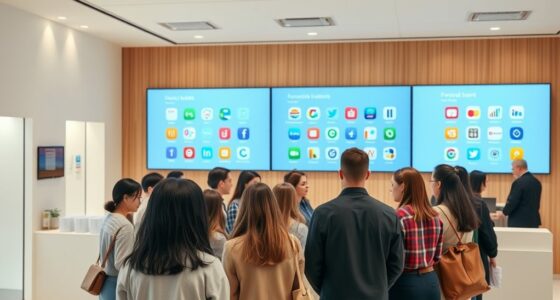Implementing design thinking in higher education shifts the focus to your needs, encouraging innovative and flexible curricula that respond to societal and industry changes. It promotes experimentation, critical skills, and collaboration, helping you develop real-world problem-solving abilities. Technology plays a key role, making learning more engaging and effective. This approach transforms the university experience into a personalized, impactful journey that prepares you for future challenges. Explore further to see how innovation shapes your educational path.
Key Takeaways
- Integrating design thinking promotes student-centered learning, making education more practical, engaging, and responsive to individual needs.
- Universities adopt dynamic curricula co-created with students, ensuring relevance and alignment with industry and societal demands.
- Emphasizing experimentation and critical thinking prepares students for real-world innovation and resilience.
- Incorporating advanced technologies enhances visualizations and active engagement within the learning environment.
- The approach shifts the university experience towards personalized, meaningful education that empowers proactive problem-solving and societal impact.

Design thinking is transforming higher education by fostering a mindset that encourages creative problem-solving and user-centered innovation. As a student, you’re at the heart of this shift, where institutions prioritize student-centered approaches to learning. Instead of traditional, lecture-based methods, universities are embracing design thinking to develop curricula that respond directly to your needs, interests, and real-world challenges. This approach guarantees that your education isn’t just theoretical; it’s practical, engaging, and tailored to help you succeed beyond the classroom. Through iterative feedback and empathy-driven processes, educators create learning experiences that resonate more deeply and prepare you for complex problem-solving in your future career.
Design thinking puts students at the center of innovative, practical, and engaging higher education experiences that prepare for real-world challenges.
Incorporating design thinking into higher education also revolutionizes curriculum development. Instead of static syllabi, institutions now approach curriculum design as a dynamic, collaborative process. You, as a student, are encouraged to participate actively, offering insights and feedback that shape your learning journey. This participatory model fosters a sense of ownership and relevance, making your education more meaningful. Faculty members work alongside students to identify gaps, brainstorm solutions, and prototype new course structures. The result is an innovative curriculum that evolves continuously, aligning better with industry demands and societal needs. This iterative process helps institutions stay agile and responsive, ensuring you gain skills that are current and applicable.
Moreover, design thinking promotes an environment where experimentation is encouraged. You’re invited to test ideas, learn from failures, and refine your approaches—mirroring real-world innovation. This mindset not only enhances your problem-solving capabilities but also builds resilience and adaptability. As you engage in project-based learning, case studies, or collaborative challenges, you develop critical thinking and creativity, essential skills in today’s fast-changing world. Universities adopting design thinking make a conscious effort to break down silos within departments, fostering cross-disciplinary collaboration. This approach exposes you to diverse perspectives, encouraging holistic and innovative solutions to complex issues.
Additionally, integrating innovative technologies such as high-quality projectors can further enhance your learning environment, making presentations and visualizations more engaging and effective. Ultimately, the integration of design thinking into higher education transforms your experience into one that’s more personalized, relevant, and forward-thinking. It shifts the focus from rote memorization to active, meaningful engagement. By emphasizing student-centered approaches and innovative curriculum development, your education becomes a powerful tool for making a positive impact on society while preparing you for the uncertainties of tomorrow’s workforce. The university experience, reimagined through design thinking, empowers you to become a proactive problem solver, ready to face challenges with confidence and creativity.
Frequently Asked Questions
How Can Faculty Be Effectively Trained in Design Thinking Methodologies?
You can effectively train faculty in design thinking by offering experiential workshops that engage them hands-on in the process. Pair this with ongoing faculty mentorship to provide support and real-world application. Encourage collaborative projects and peer feedback to deepen understanding. This approach helps faculty integrate design thinking into their teaching, fostering innovation and improving the overall university experience. Consistent practice and mentorship are key to sustaining their skills.
What Challenges Do Universities Face When Implementing Design Thinking Initiatives?
You’ll face challenges like cultural resistance, where staff and faculty may be hesitant to adopt new approaches, and resource constraints that limit training, tools, and time. Overcoming cultural resistance requires demonstrating value and fostering openness to innovation. Resource constraints demand strategic planning and prioritization. By addressing these issues proactively, you can create a supportive environment that encourages experimentation and long-term success with design thinking initiatives.
How Does Design Thinking Impact Student Engagement and Learning Outcomes?
When you embrace design thinking, you boost student engagement and learning outcomes by making education more hands-on and relevant. This approach encourages innovative assessment methods and experiential learning, helping students connect theory to real-world issues. It’s like hitting two birds with one stone—you foster deeper understanding while keeping students motivated. As a result, students become more active participants, developing critical thinking skills that prepare them for future challenges.
Are There Specific Tools or Platforms That Facilitate Design Thinking in Higher Education?
You can use various digital collaboration tools like Miro, MURAL, or Google Jamboard to facilitate design thinking in higher education. These platforms enable seamless teamwork, idea sharing, and real-time feedback. Prototyping platforms like Figma or Adobe XD help students create and test their solutions quickly. These tools foster creativity, encourage collaboration, and streamline the design process, making it easier to implement and explore innovative ideas within academic settings.
How Can Design Thinking Foster Collaboration Across Different Academic Disciplines?
Like gears turning together smoothly, design thinking encourages collaboration across disciplines. You can do this through interdisciplinary workshops, where students and faculty from diverse fields work on shared challenges. This approach fosters creative ideas and innovative solutions through collaborative problem solving. By breaking down silos, you create a dynamic environment that promotes mutual understanding, sparks new insights, and drives meaningful progress across academic boundaries.
Conclusion
So, here you are, reimagining higher education through design thinking, hoping to create a perfect university experience. Ironically, in trying to innovate and improve, you might just rediscover that the best solutions often come from simply listening and empathizing—things universities have long overlooked. Maybe, in the end, the most radical idea is realizing that sometimes, the answer isn’t reinventing the wheel but just making it roll smoother. Who knew?









